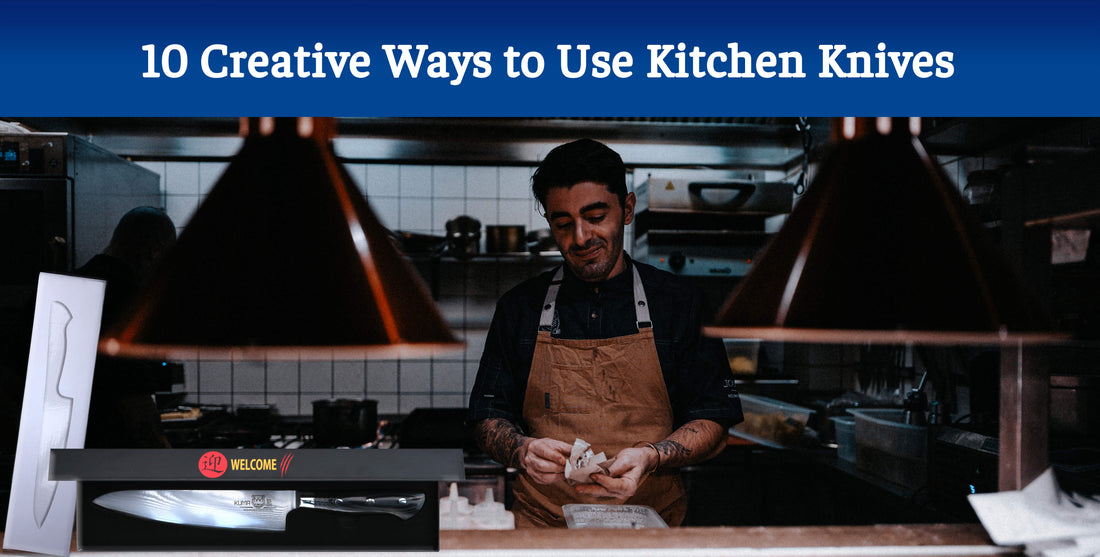
10 Creative Ways to Use Kitchen Knives.
Share
10 Clever Ways to Use Kitchen Knives when Cooking.
Kitchen knives are essential tools in any home chef's arsenal, but they can be used for much more than just chopping and slicing. Whether you're a beginner cook or a seasoned pro, these creative ways to use kitchen knives in the kitchen will help you elevate your dishes and save time and effort in the kitchen.
Let's look at 10 clever ways you can start using your kitchen knife today:
- Serrated knife for soft bread: A serrated knife is perfect for slicing soft bread without crushing it. Simply saw back and forth with a gentle sawing motion to get perfect slices every time. This technique is especially useful for artisan breads with a soft, fluffy interior and a crispy crust.
- Paring knife for decorative garnishes: A small paring knife is great for creating decorative garnishes for platters or plates. Try using it to thinly slice vegetables into thin strips or flower shapes, or to create intricate designs on fruit. These decorative touches can add an extra touch of elegance to any dish.
- Chef's knife for crushing spices: If you don't have a mortar and pestle, a chef's knife can be used to crush spices. Simply lay the spices on a cutting board and press down on them with the flat side of the knife, using a rocking motion. This is a quick and easy way to release the flavors of whole spices and make them more readily available for cooking.
- Utility knife for precision tasks: A utility knife is a versatile tool that can be used for a variety of tasks in the kitchen. Its smaller size makes it great for precision tasks like trimming fat from meat or slicing small items like cherry tomatoes. Its thin, sharp blade is also great for making precise cuts and slicing through softer foods with ease.
- Boning knife for deboning meat: A boning knife is specifically designed for deboning meat, with a narrow, flexible blade that can easily maneuver around bones. It's also useful for trimming fat and silver skin from meats. If you're planning to cook a whole chicken or turkey, a boning knife can be a lifesaver for removing the bones and creating a deboned bird.
- Santoku knife for thin slicing: A Santoku knife is a versatile Japanese knife that's great for thin slicing. Its shorter, wider blade is perfect for slicing thin sheets of meat, fish, or vegetables, and it's also useful for dicing and mincing.
- Bread knife for crusty loaves: A bread knife is essential for slicing through crusty loaves of bread without crushing the soft interior. Its long, serrated blade is perfect for sawing through even the toughest crusts, and it's also useful for slicing through other dense baked goods like cake or dense fruit breads.
- Fillet knife for fish: A fillet knife is specifically designed for filleting fish, with a thin, flexible blade that can easily maneuver around bones and remove the flesh from the skin. It's also useful for slicing through thin cuts of meat or poultry.
- Cleaver for heavy-duty tasks: A cleaver is a large, heavy knife with a thick blade that's great for tackling heavy-duty tasks in the kitchen. It's perfect for chopping through bones, tough vegetables, or large cuts of meat, and it's also useful for crushing nuts or garlic.
- 10.Honing rod for maintaining sharp edges: A honing rod is a useful tool for maintaining the sharp edges of your kitchen knives. Simply run the blade of your knife along the rod using a back and forth motion to straighten out any bends
By getting creative with your kitchen knives and using them for a variety of tasks, you can save time and effort in the kitchen, and elevate your dishes to the next level. Whether you're a beginner cook or a seasoned pro, these creative knife techniques are sure to come in handy. Remember to always use caution when handling knives, and to regularly maintain and sharpen them to keep them in top condition. With the right tools and techniques, your kitchen knives can be an invaluable asset in the kitchen, helping you create delicious and impressive dishes with ease.
